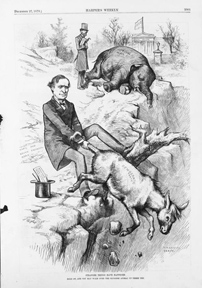RONALD REAGAN loved to tell the story of the unfailingly cheerful little boy who wakes up on Christmas morning to find, instead of presents, an immense pile of manure. Undaunted, he grabs a shovel and starts digging. “With all this manure,” he says excitedly, “there must be a pony in here someplace!”
Is there a pony somewhere in the $825 billion “stimulus” plan that Democratic leaders in the House of Representatives hope to bring to a vote today? Last week, the Congressional Budget Office started digging into this immense pile of -- uh, deficit spending, and what it found would discourage even a Reagan-caliber optimist.
According to the CBO, less than half of the $355 billion the bill allocates to infrastructure and other “discretionary” projects would actually be spent by the end of 2010; of that, a mere $26 billion would be spent in the current fiscal year. “The rest would come in future years,” the Washington Post reported, “long after the CBO and other economists predict the recession will have ended.” (After Congressional Democrats expressed displeasure with the CBO’s findings, the report was mysterious yanked off the internet. A new version appeared yesterday with -- presto! -- numbers more to the Democrats’ liking.)
Wasn’t the whole point of turbocharging this stimulus bill -- recall that President Obama had originally hoped it would be ready for his signature on Inauguration Day -- that there is no time to waste in pumping these funds into the economy? “If we do not act boldly and swiftly,” the president warned in his weekly address on Saturday, “a bad situation could become dramatically worse.”
Yet of the $30 billion the House bill allots for highway projects, less than $4 billion would be spent before 2011, according to the CBO’s original calculcations. Of $18.5 billion earmarked for renewable energy, less than $3 billion would make it through the pipeline within two years. Of $14 billion for school construction, only half would be used by the end of next year. The administration claims that vast fiscal intervention is urgently required to “save or create” as many as 4 million jobs by the end of next year. Even if you buy the Keynesian argument that mammoth deficit spending will jump-start economic growth, it’s tough to see how it does so by the end of next year if most of the outlays only occur thereafter.
In truth there are compelling reasons not to buy the whole spending-equals-stimulus line of reasoning. Echoing Richard Nixon, Time magazine recently proclaimed that “we all really do seem to be Keynesians now” and that “just about every expert agrees that pumping $1 trillion into a moribund economy” is the way to “rev up” aggregate demand and stimulate economic activity. Time clearly didn’t check with George Mason University economist Russell Roberts, who wrote on Monday: “As far as I know, no prominent market-oriented economist has come out in favor of a trillion-dollar increase in government spending as a way to improve the economy.”
One such prominent market-oriented economist, Nobel laureate Gary Becker, wrote last week that some of the spending projects in the Democratic stimulus plan “may be very worthwhile . . . but however merited, it is difficult to believe that they would provide much of a stimulus to the economy.” Budget analyst Brian Riedl of the Heritage Foundation points out that “mountains of academic studies show how government expansions reduce economic growth.” A 1997 study in Public Finance Review, for example, concluded that “higher total government expenditure, no matter how financed, is associated with a lower growth rate.” In the Journal of Macroeconomics, another study found that “a 1% increase in government size decreases the rate of economic growth by 0.143%.”
Real-world evidence of the inefficacy of pump-priming abounds. For starters, there was last year’s massive increase in federal spending, including $105 billion in tax rebates and more than $300 billion in “emergency” spending, not to mention passage of the $700 billion financial-sector bailout. None of it revived the economy. In the 1990s, Japan tried without success to deficit-spend its way out of recession, enacting 10 “stimulus” bills in eight years and spending trillions of yen on public infrastructure. Yet unemployment grew worse, the economy remained anemic, and Japan was left with the largest national debt in the industrialized world: 170 percent of GDP.
Will we follow Japan’s lead? US government spending is at record-busting levels, budget deficits have never been greater, and the national debt is closing in on a once-unimaginable $11 trillion. We are in over our collective head in debt, and our economy is reeling. Borrowing even more heavily will not make things better.
An over-optimistic stimulus plan
by Jeff Jacoby
The Boston Globe
January 28, 2009
http://www.jeffjacoby.com/3256/an-over-optimistic-stimulus-plan

No comments:
Post a Comment